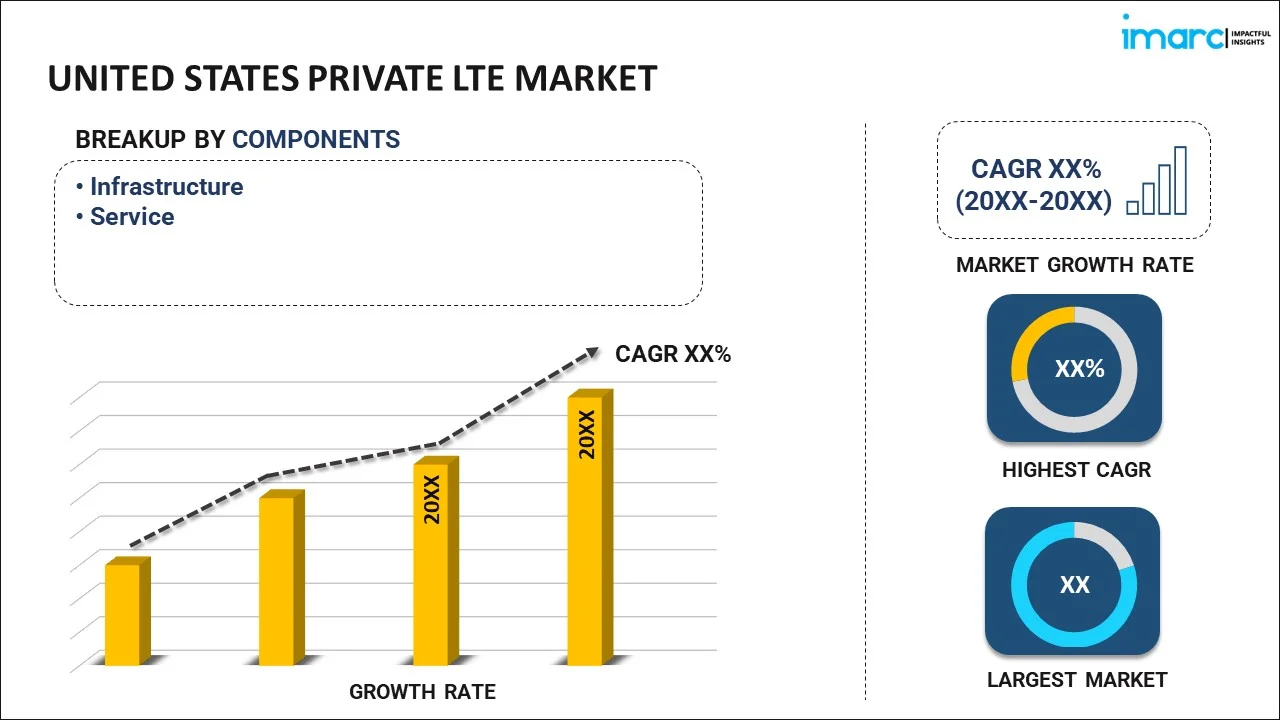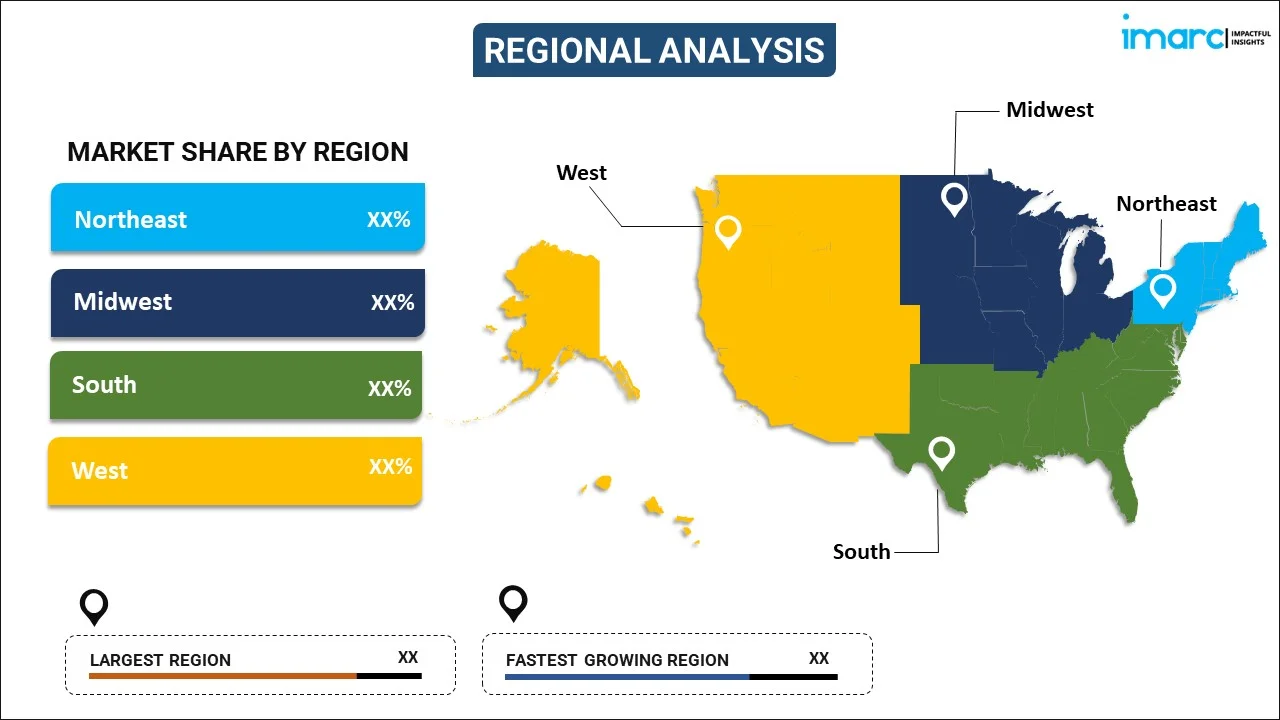
United States Private LTE Market Report by Component (Infrastructure, Service), Technology (FDD, TDD), Frequency Band (Licensed, Unlicensed, Shared Spectrum), Deployment Model (Centralized, Distributed), Industry Vertical (Healthcare, IT and Telecom, Manufacturing, Retail and E-commerce, Government and Defense, Energy and Utility, Oil and Gas, Education, and Others), and Region 2024-2032
Market Overview:
United States private LTE market size is projected to exhibit a growth rate (CAGR) of 26.30% during 2024-2032. The increasing demand for private LTE networks, which offer high data speeds, low latency, and reliability, making them suitable for applications that require robust and secure connectivity, is driving the market.
|
Report Attribute
|
Key Statistics
|
|---|---|
|
Base Year
|
2023 |
|
Forecast Years
|
2024-2032 |
|
Historical Years
|
2018-2023
|
| Market Growth Rate (2024-2032) | 26.30% |
Private LTE (long-term evolution) refers to a wireless communication technology that provides high-speed data transfer and connectivity within a dedicated and secure network. Unlike traditional LTE networks operated by telecommunications carriers, private LTE networks are independently owned and managed by organizations for their specific needs. These networks offer reliable and low-latency communication, making them suitable for various industries such as manufacturing, healthcare, and logistics. Private LTE is particularly advantageous in environments with unique requirements, such as those needing extensive coverage, high device density, or critical communication reliability. It enables organizations to have greater control over their network infrastructure, ensuring data privacy, security, and efficient management of connected devices. This technology has become increasingly popular for businesses seeking tailored and secure wireless solutions to support their specific operational demands.
United States Private LTE Market Trends:
The private LTE market in the United States is experiencing unprecedented growth, propelled by a confluence of factors. Firstly, the increasing demand for reliable and high-performance connectivity in sectors such as manufacturing, healthcare, and transportation is a significant driver. This is underscored by the need for low-latency communication, a requirement seamlessly addressed by private LTE networks. Furthermore, the surge in Industrial Internet of Things (IIoT) deployments has been a key catalyst, with businesses recognizing the imperative of robust and dedicated connectivity to support the proliferation of connected devices. In addition to this, the escalating adoption of Industry 4.0 practices has further fueled the demand for private LTE solutions. The need for secure, low-latency and high-bandwidth communication networks is integral to the successful implementation of smart manufacturing processes. Moreover, the increasing emphasis on digital transformation across industries, which has elevated the importance of private networks, as they provide a dedicated and controlled environment for data transmission and communication, is expected to drive the private LTE market in the United States during the forecast period.
United States Private LTE Market Segmentation:
IMARC Group provides an analysis of the key trends in each segment of the market, along with forecasts at the country level for 2024-2032. Our report has categorized the market based on component, technology, frequency band, deployment model and industry vertical.
Component Insights:

- Infrastructure
- Service
The report has provided a detailed breakup and analysis of the market based on the component. This includes infrastructure and service.
Technology Insights:
- FDD
- TDD
A detailed breakup and analysis of the market based on the technology have also been provided in the report. This includes FDD and TDD.
Frequency Band Insights:
- Licensed
- Unlicensed
- Shared Spectrum
The report has provided a detailed breakup and analysis of the market based on the frequency band. This includes licensed, unlicensed, and shared spectrum.
Deployment Model Insights:
- Centralized
- Distributed
A detailed breakup and analysis of the market based on the deployment model have also been provided in the report. This includes centralized and distributed.
Industry Vertical Insights:
- Healthcare
- IT and Telecom
- Manufacturing, Retail and E-commerce
- Government and Defense
- Energy and Utility
- Oil and Gas
- Education
- Others
The report has provided a detailed breakup and analysis of the market based on the industry vertical. This includes healthcare, IT and telecom, manufacturing, retail and E-commerce, government and defense, energy and utility, oil and gas, education, and others.
Regional Insights:

- Northeast
- Midwest
- South
- West
The report has also provided a comprehensive analysis of all the major regional markets, which include Northeast, Midwest, South, and West.
Competitive Landscape:
The market research report has also provided a comprehensive analysis of the competitive landscape in the market. Competitive analysis such as market structure, key player positioning, top winning strategies, competitive dashboard, and company evaluation quadrant has been covered in the report. Also, detailed profiles of all major companies have been provided.
United States Private LTE Market Report Coverage:
| Report Features | Details |
|---|---|
| Base Year of the Analysis | 2023 |
| Historical Period | 2018-2023 |
| Forecast Period | 2024-2032 |
| Units | Million US$ |
| Scope of the Report | Exploration of Historical Trends and Market Outlook, Industry Catalysts and Challenges, Segment-Wise Historical and Future Market Assessment:
|
| Components Covered | Infrastructure, Service |
| Technologies Covered | FDD, TDD |
| Frequency Bands Covered | Licensed, Unlicensed, Shared Spectrum |
| Deployment Models Covered | Centralized, Distributed |
| Industry Verticals Covered | Healthcare, IT and Telecom, Manufacturing, Retail and E-commerce, Government and Defense, Energy and Utility, Oil and Gas, Education, Others |
| Regions Covered | Northeast, Midwest, South, West |
| Customization Scope | 10% Free Customization |
| Report Price and Purchase Option | Single User License: US$ 3699 Five User License: US$ 4699 Corporate License: US$ 5699 |
| Post-Sale Analyst Support | 10-12 Weeks |
| Delivery Format | PDF and Excel through Email (We can also provide the editable version of the report in PPT/Word format on special request) |
Key Questions Answered in This Report:
- How has the United States private LTE market performed so far and how will it perform in the coming years?
- What has been the impact of COVID-19 on the United States private LTE market?
- What is the breakup of the United States private LTE market on the basis of component?
- What is the breakup of the United States private LTE market on the basis of technology?
- What is the breakup of the United States private LTE market on the basis of frequency band?
- What is the breakup of the United States private LTE market on the basis of deployment model?
- What is the breakup of the United States private LTE market on the basis of industry vertical?
- What are the various stages in the value chain of the United States private LTE market?
- What are the key driving factors and challenges in the United States private LTE?
- What is the structure of the United States private LTE market and who are the key players?
- What is the degree of competition in the United States private LTE market?
Key Benefits for Stakeholders:
- IMARC’s industry report offers a comprehensive quantitative analysis of various market segments, historical and current market trends, market forecasts, and dynamics of the United States private LTE market from 2018-2032.
- The research report provides the latest information on the market drivers, challenges, and opportunities in the United States private LTE market.
- Porter's five forces analysis assist stakeholders in assessing the impact of new entrants, competitive rivalry, supplier power, buyer power, and the threat of substitution. It helps stakeholders to analyze the level of competition within the United States private LTE industry and its attractiveness.
- Competitive landscape allows stakeholders to understand their competitive environment and provides an insight into the current positions of key players in the market.
Need more help?
- Speak to our experienced analysts for insights on the current market scenarios.
- Include additional segments and countries to customize the report as per your requirement.
- Gain an unparalleled competitive advantage in your domain by understanding how to utilize the report and positively impacting your operations and revenue.
- For further assistance, please connect with our analysts.
 Inquire Before Buying
Inquire Before Buying
 Speak to an Analyst
Speak to an Analyst
 Request Brochure
Request Brochure
 Request Customization
Request Customization




.webp)




.webp)












